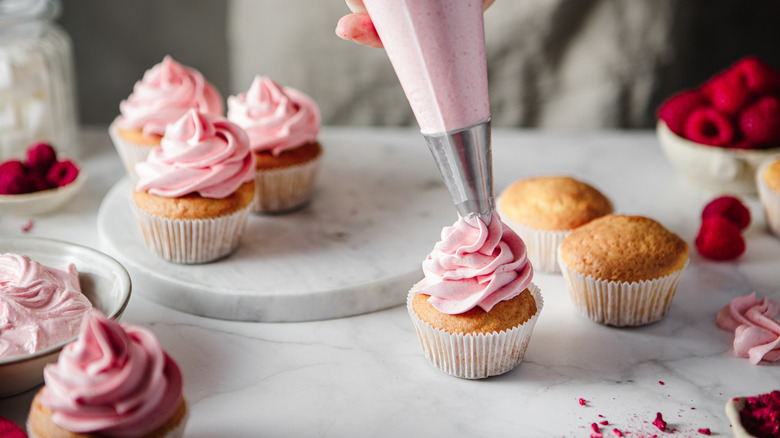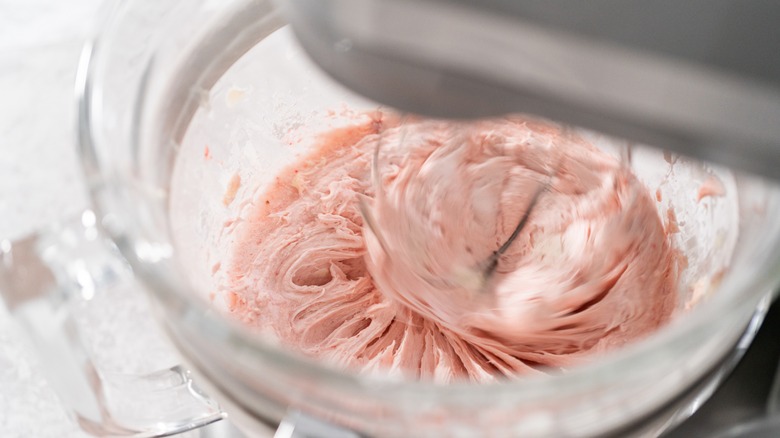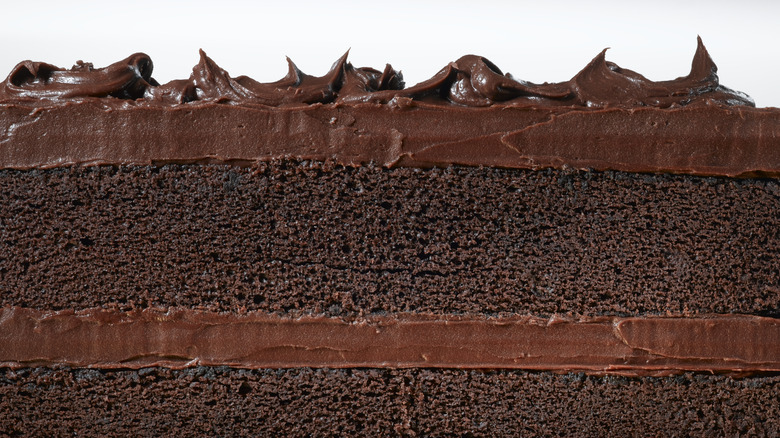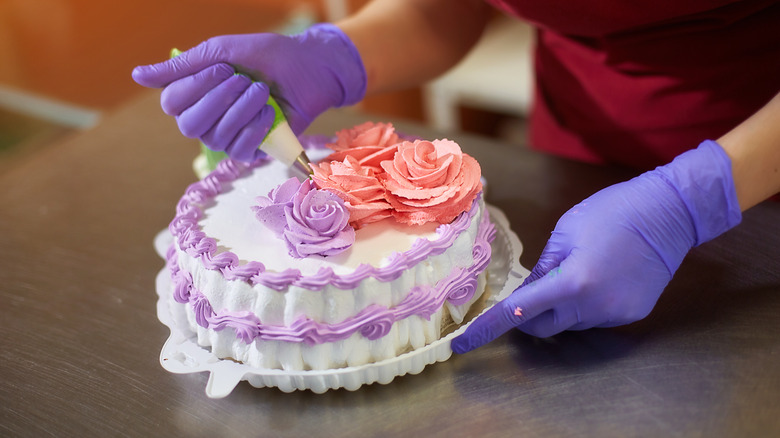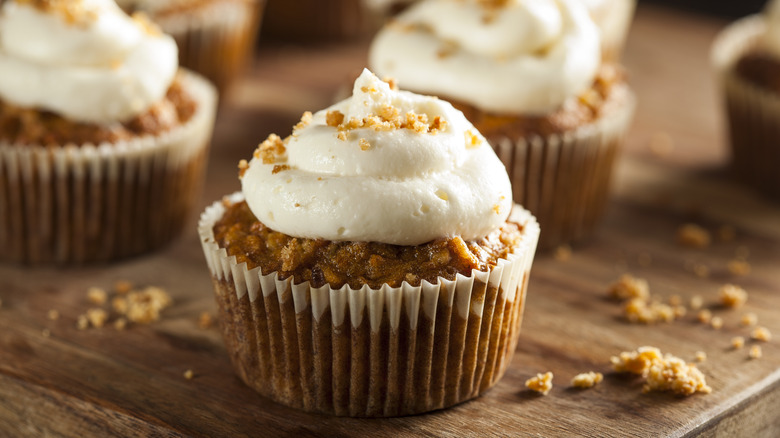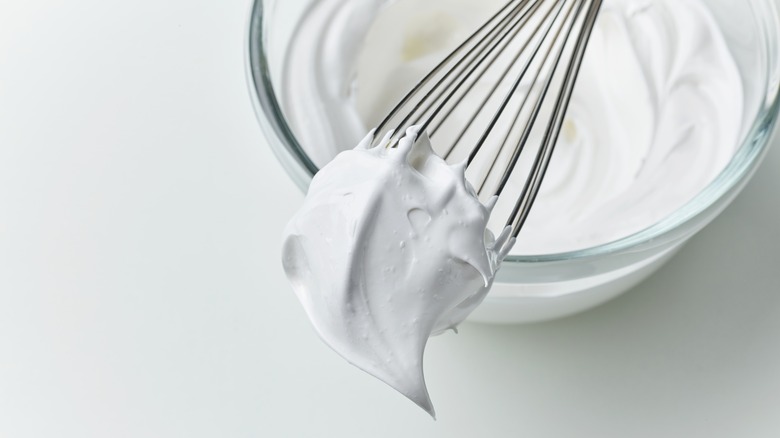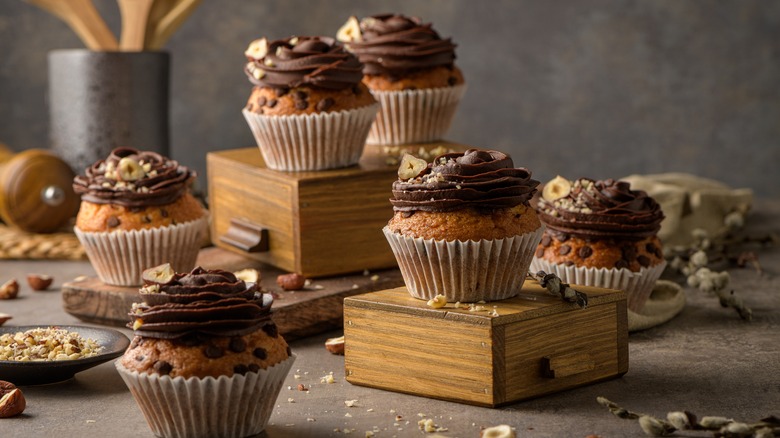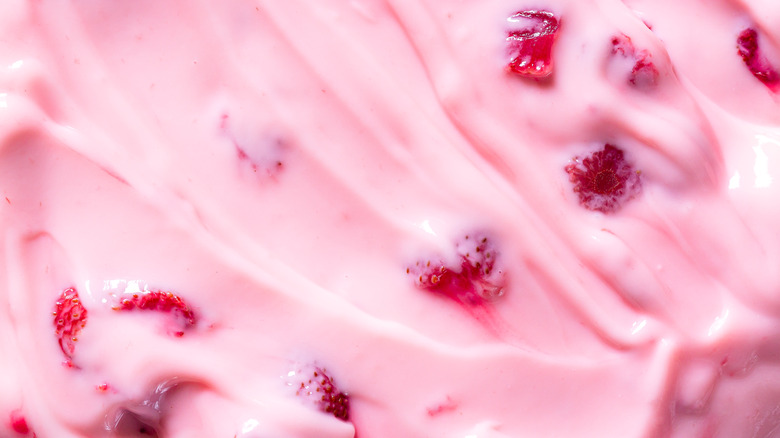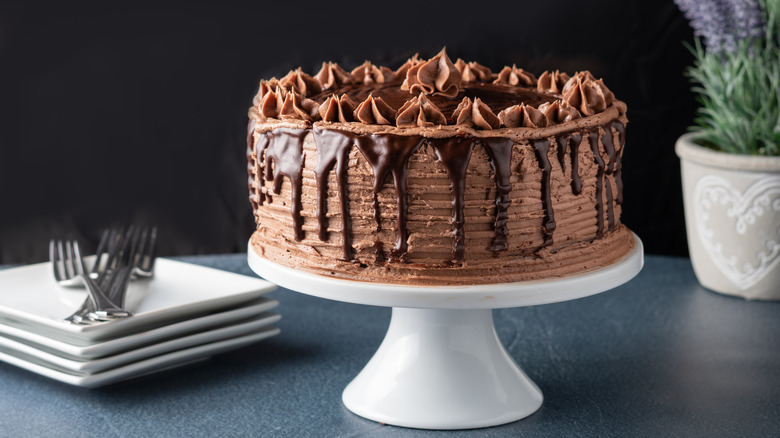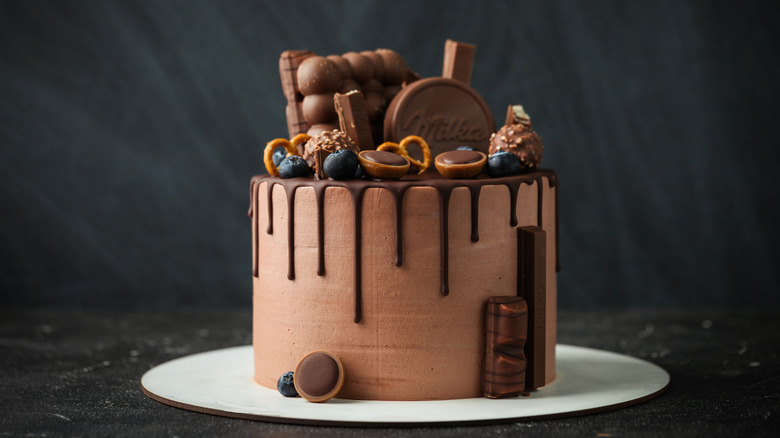10 Tips You Need To Elevate Store-Bought Frosting
What better way is there to take a cake from good to sensational than by covering it in frosting? Whether it's simply presented or elegantly piped into flowers and embellishments, the different kinds of frosting all add something special to the finished dessert. Many bakers prefer to make homemade frosting because it's versatile and can be tweaked in countless ways to achieve special flavors and textures. It's usually made from genuine ingredients, which makes it taste great, and you can't beat the rewarding feeling of making something with your own hands.
While it would be great to make frosting from scratch every time, it's easier to reach for a can of store-bought frosting when you're short on time or crave convenience. Purchased frosting tends to be denser and sweeter than many homemade varieties and has a limited range of textures, but there are many ways to spruce up a can of store-bought frosting and use it to create deliciously decadent desserts. Look at it as a blank canvas that can be combined with homemade techniques or additional ingredients to enjoy the best of both worlds. These tips focus on enhancing the flavor of store-bought frosting, improving the texture, and boosting the appearance. Try these suggestions to take your desserts to the next level and leave your family and friends asking for more.
Whip frosting to make it seem more homemade
Many people prefer homemade frosting because it's not as dense as store-bought frosting. If you can't make your own, there is a simple hack that will transform your store-bought frosting. All you have to do is whip it, and you will see the consistency start to change immediately. Remove the frosting from the container and place it in a mixing bowl. Whip using either a stand mixer with the whisk attachment or a handheld mixer. The whipping action traps air inside the frosting, and this extra air will change it from compact to delightfully light and fluffy.
Something else magical will happen, too — the added air will actually make the frosting double in size. So besides improving the texture, you'll end up with twice as much frosting as you started out with. This is an advantage if you have a lot of baked goods to decorate or a large multi-layered cake that needs more than one can of store-bought frosting to be completely covered. Since store-bought frosting can be a lot sweeter than many people prefer, the volume increase will balance out that overly sweet taste and make each bite taste better.
Make it thinner
Since commercial frosting tends to be heavier and more compact, another way to make store-bought frosting seem more homemade is to make it thinner. When you make homemade frosting, you can just add more of whatever liquid the recipe calls for until it reaches the right consistency. With store-bought frosting, you can add milk or water to achieve the same result. Milk will be more flavorful than water, but they both get the job done. Whole milk or coconut milk (with the cream) will give you the creamiest result, or you can choose soy, almond, oat, or any other non-dairy milk you prefer. Add the liquid 1 tablespoon at a time until it's as thin as you want it. If you already refrigerated the can of frosting, make sure you bring it back to room temperature before stirring, or it will be very firm and hard to stir.
While milk and water are the most common liquids to thin frosting, there are other possibilities. Certain liqueurs will not only act as thinning agents but will also add a special flavor to the topping. Sambuca is a tasty choice for an anise-flavored frosting, and limoncello is great for lemon cakes. Amaretto provides a sweet, almondy taste, and Southern Comfort will give your dessert a spicy and fruity flavor. Coffee lovers can add liquid espresso, which goes well with chocolate frosting. Add liqueurs or coffee one tablespoon at a time, just like you would with milk or water.
Thicken it up
While a thinner or fluffier frosting will seem more homemade than the heavier store-bought kind, there are times you may want to make purchased frosting even thicker for decorating. Think piping, scallops, flowers, and other beautiful embellishment used in the art of cake decorating. You need firm frosting for these to stand up and keep their shape.
One way to firm up canned frosting is to add powdered sugar. Mix in 1 tablespoon at a time until it's as thick as you need it. You can also use cornstarch to fix thin frosting because cornstarch is a thickening agent and will help to stiffen the mixture. If you have them both, mix cornstarch and powdered sugar together. Believe it or not, you can add marshmallow fluff to stiffen buttercream frosting as well because this sweet, thick spread will add more body and structure to the original product. If you don't need to pipe it and if you like the flavor, coconut flakes or shredded coconut will also thicken things up.
Don't add butter to thicken it, though, because butter, while solid at room temperature, will soften considerably outside of the fridge. Be conservative with whipping, because the air that enters the frosting from whipping will make the result lighter and fluffier. If the frosting contains cornstarch, whipping or beating it too much can cause graininess, so stop beating as soon as stiff peaks form.
Add cream cheese
Cream cheese frosting is an extra rich, tangy yet sweet topping that pairs beautifully with carrot cake, spice cake, red velvet cake, and many other kinds of desserts. You can enrich store-bought frosting by adding one 8-ounce package of cream cheese to one can of frosting. Make sure the frosting is at room temperature, and take the cream cheese out of the refrigerator 30 to 60 minutes ahead of time. The cheese should be softened, but still cold. You can be creative with which frosting you add cream cheese to, but you can use vanilla or chocolate for a more traditional taste. Adding a teaspoon of vanilla extract will complement the cream cheese and add extra homemade flavor to the end result at the same time.
Use a brick of cream cheese, not a spread. The cream cheese spread has been whipped to add air to the mixture, and this makes it lighter and spreadable right out of the refrigerator when it's still cold, which is great for your breakfast bagel on the go, but it's not as ideal for a cake. The brick of cream cheese is firmer, which helps with piping, and it contains more fat, which contributes to an extra decadent taste.
Mix in whipped cream
There are many reasons to love this decadent addition to sweet treats. With its high fat content, whipped cream adds a smooth mouthfeel to desserts, and the sweetness is a delicious finishing touch. If you buy high-quality heavy cream and make it yourself, it's even sweet enough for some people's tastes without any additional sugar. But did you know that you can improve store-bought frosting by adding whipped cream? It will improve the frosting's texture by making it creamier and fluffier and will tone down the overly-sweet taste of the commercial product.
Mixing the whipped cream in by hand with a fork or folding it in with a spatula is fine, but make sure the frosting is at room temperature before attempting this, or it will be too hard to stir. For extra fluffy results, however, use an electric hand mixer or a stand mixer. This vigorous mixing will incorporate air into the frosting, making it light and voluminous.
You can use defrosted frozen whipped cream topping, or you can make your own whipped cream at home, which is a lot simpler than it may seem. Just whip very cold heavy cream until medium-firm peaks appear and it has doubled in size. Stay away from the spray can kind of whipped cream, which will quickly turn runny. Add 16 ounces of whipped cream per 16-ounce can of frosting.
Flavor or color will add some pop
While some methods used to improve store-bought frosting require whipping or heating, an easy way to enhance this product is to just stir in some extra flavor or color. A fork will work, or you can choose to use a hand mixer to evenly incorporate the flavoring more quickly.
The simplest thing to add is a teaspoon or two of vanilla extract to a can of store-bought frosting. Other kinds of extracts will add interest and special flavors that can complement the ingredients in your cake or dessert. Try a few drops of almond, orange, lemon, coffee, peppermint, rum, or even birthday cake extract.
Color is another fun way to spruce up your frosting. A few drops of liquid food coloring go a long way in a vanilla frosting, and be sure to mix well. Have fun mixing colors to create the tints you want, or mix up a few different colors and create a rainbow effect. Try a small scoop of gel icing color for thicker frostings. Unlike classic food coloring, the gel kind doesn't add any liquid, and as an added bonus, it comes in more lively colors.
Combine frosting with additional ingredients
Pump up store-bought frosting with additional ingredients that add crunch, texture, or a deeper flavor. There's certainly no shortage of options. Intensify the flavor by adding peanut butter or espresso powder dissolved in hot water to chocolate frosting. Toss toasted chopped nuts into the frosting and mix until just combined for a crunchy texture and a more refined look. Walnuts, almonds, hazelnuts, pistachios, and macadamia nuts are good options, but any nut you like will work. If you'd like a nutty flavor without the chunky pieces, opt to pulse the nuts in a food processor first until they reach the consistency of breadcrumbs, which is a must if you want the nutty flavor but are planning to pass the frosting through an icing tip.
Many other textured ingredients like chocolate chips, coconut flakes, freeze-dried fruit, and sprinkles are good additions to store-bought frosting. Carefully fold in rainbow sprinkles with a spatula to prevent their color from bleeding into the white icing. Whatever you use, start with a small amount and add more as needed. Plain vanilla and chocolate frostings are a blank canvas for experimenting with textured mix-ins, but other flavors practically call out for complementary additions. For example, commercial cream cheese frosting loves shredded coconut, and chopped walnuts go well with maple spice frosting. Stir some hazelnuts into chocolate frosting, freshly grated lemon zest into a lemon frosting, or dark chocolate chips into a salted caramel one.
Use fresh fruit or preserves
Fresh fruit is an excellent addition to store-bought frosting because the pure flavor of ripe fruit will add a natural flavor that balances out the flavor of processed food. You can achieve this in several ways. Fresh fruit that's soft and ripe can be blended and then mixed into the frosting. Firmer fresh fruits that will keep their shape can be chopped up and stirred in, and you can experiment with fruits you like or with what's in season. Try adding strawberries to a vanilla or strawberry-flavored frosting, peaches to a vanilla one, or cherries to a chocolate version.
There are many types of fruit preserves, and they are also good options for adding flavor and can be used any time of the year if fresh fruit isn't in season. Start with a spoonful and fold it into your frosting. Add more a spoonful at a time until it's as flavorful as you like. Blueberry, strawberry, and apricot preserves, orange marmalade, or mint jelly are all examples that can complement store-bought frosting. Adding freshly grated zest of lemons or oranges is another way to brighten up the flavor of store-bought frosting and add a fresh fruit flavor and delightful aroma.
More chocolate flavor never hurts
How could these tips be complete without mentioning chocolate? While chocolate-flavored store-bought frosting exists, chocolate lovers agree that you can always add more. Play up the texture of smooth chocolate frosting by adding texture. Chocolate chips, chocolate chunks, and chocolate sprinkles all add crunch while intensifying the chocolaty flavor of each bite at the same time.
Cocoa powder will also amplify the chocolate flavor. Choose a high-quality dark cocoa powder with no additional ingredients like sugar — store-bought frosting is already very sweet, so the idea is just to contribute more chocolate flavor. Add a spoonful at a time and perform taste tests until you like the result. Be careful not to add too much, or it might get chalky or bitter.
Another way to add chocolate flavor is to drizzle melted chocolate on your frosting. There are different ways to melt chocolate, but it can be as simple as heating chocolate chips in the microwave. This method is a good idea for adding a finishing touch to desserts that are already frosted with store-bought frosting. Drizzle the melted chocolate on top not just for extra chocolate flavor but for a beautiful finish, as well. Use dark, milk, or white melted chocolate depending on the visual look you are going for.
Transform it into a glaze
A glaze is a translucent mixture that is poured on cakes and other sweet treats as a finishing touch. Glazes and frosting are different things, but it's actually possible to transform store-bought frosting into a kind of glaze you can use to top your baked goods. Scoop the frosting out of the can and place it in a microwave-safe bowl. Microwave for up to 30 seconds, give it a good stir, and immediately pour it over your creation. Stir in a little vegetable oil or warm milk after heating if it's still too thick, and make sure to avoid adding water if the frosting is chocolate.
Another method is to enhance store-bought frosting by applying a separate glaze over it. After you've first frosted your dessert normally, pour or drizzle the glaze on top for a finishing touch that adds flavor and shine. You can make a glaze in many ways. The simplest way is to combine powdered sugar with a small amount of water until it's liquid enough to pour — just act quickly before it hardens in the bowl. Make a citrus glaze by mixing the powdered sugar with freshly squeezed orange juice or lemon juice instead of water. A caramel sauce can be created with butter, brown sugar, vanilla extract, and milk or heavy cream. It's used in the same way as other glazes to create an irresistible finish.
